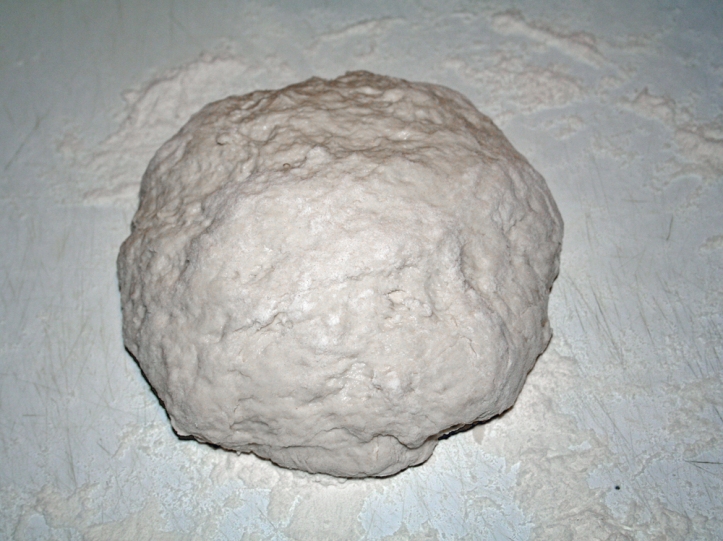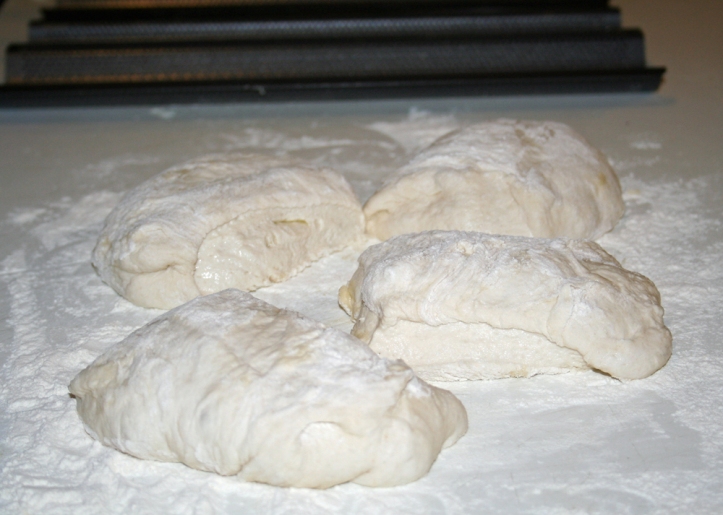Last week, I was reading through Glenda’s (@ Passion Fruit Garden) post on sourdough baguettes, which I have to say looked spectacular. Apparently, she as inspired by my post entitled Figgy & Cheesy about a fig, caramelised onion and goat cheese crostini (which, of course, starts with baguettes). Glenda’s trials and tribulations brought home to me just how diverse sourdough creations can be simply based on the variable properties of the basic ingredients plus the diverse climate conditions where dedicated bakers are churning out sourdough bread across the globe. Naturally, Glenda’s baguettes in Perth, Western Australia, were not made with the same ingredients as mine nor were they made under the same weather conditions as the sourdough baguettes I made in Yorkshire, Northern England. I am, even now, finding that I have to make adjustments when making bread of any kind in the kitchen in Athens.
Harold McGee, in his brilliant book, On Food and Cooking, takes the reader through the basic ingredients in breadmaking – flour, water and salt in addition to the sourdough starter which contains the yeast. McGee does a good job explaining how variables in each of these ingredients affect the end result. Most people who bake bread know about flour – particularly protien (that is, gluten) content – strong bread flours produce breads with different textures from those made with all-purpose flour. Some bakers prefer strong flours, others prefer all-purpose ones, but great breads are made with both. More variables come into play with the age of the flour (how long has it been sitting in your pantry?), and with different commercial brands (and whether they are organic or not). What is less talked about is the compactness of flours that affect volume, the reason behind weighing rather than relying on volume measurements like cups.
The next major ingredent is water. Acid or alkaline? Acid waters weaken gluten while alkaline strenghtens it. Hard water (alkaline), which contains calcium, produces a firmer dough. Of course the ratio of water to flour (the hydration percentage – measured by dividing the weight of water by the weight of the flour and multiply by 100) also affects the texture. It seems common sense that less water produces a firmer dough and a denser bread while more water produces a softer, less elastic and more open textured bread. For example, the water in my UK kitchen is slightly acidic – the reason why we are able to grow those azaleas, rhodedendrons and blueberries in the garden. However, the water in Athens is definitely alkaline, filled with calcium particles that we are constantly having to clean out of the filter on the kitchen tap.
A small amount of salt is a significant addition to bread dough, although there are some traditional breads made without salt, such as those found in Tuscany. Salt toughens the gluten network and improves the volume. Unrefined salt (such as many sea salts) with calcium, magnesium and other impurities furthers gluten strengthening – similar to the affect of hard water. Salt is also important particularly in sourdough breads as it inhibits the protien digesting bacteria which produces the characteristic sour taste. How much you need depends on other variables as well as one’s particular tastes.
Each sourdough starter has its own personality (hence our propencity for naming them). Sourdough starter hydration percentages vary. Muriel, my sourdough starter, is a 100% hydration, which means that when she is fed, she gets an equal amount (weight) of water and flour. Starter feeding and storing regimes also differ. Mine is fed at least once a week (sometimes more) and is stored in the refrigerator in between uses. I am also convinced that sourdough starters vary by terroir, the concept that indicates the environment affects plants or animals in the food chain. This would also, to my mind, include live wild yeast cultures. It would seem unlikely that those cultures would be homogeneous across the globe. So, the wild yeasts Muriel is now picking up in Greece differ from those she was exposed to back in the UK and most likely affect not only the taste, but performance as a levening agent as well.
And, that’s just the variables associated with ingredients!
McGee does not cover variables in bread making affected by the climate, but there is a lot of information out there on internet forums or various blogs that specialise in breads, particularly sourdough. Generally, humidity affects the hydration and compactness of the flour, rise times differ in warmer versus cooler places, and sea levels/altitude (as most of us know) also affect baking.
Many experienced bread makers say that it is all about achieving the right texture of dough – adding a little more flour here, or a little more water there. It is choosing the method you are comfortable with for kneeding or stretching the gluten strands to the right amount of elasticity. It is also about the resting, the proving – quick in a warm environment, or slowed down in the refrigerator – or if there are multiple rises. In other words, it is a subjective process that requires you to have a knowledge of your ingredients and the dough making process. Then, the variables associated with the actual baking (as no home oven is the same). These also need to be considered and understood.
No recipe can replace the knoweledge you acquire with time and experience. Of course there will always be a number of failures. The important thing is to keep baking.









Great post Deb, if only wheat flour and I could be friends…..
LikeLike
I know what you mean…with flour, that is. Knowing your ingredients when making other things, too, is very important. I guess another reason to shop and cook locally.
LikeLike
Hi Debi, You are so right in every regard. It is my understanding that a sourdough starter that is transported will very quickly pick up local characteristics and bare little resemblance to is previous identity.
LikeLiked by 1 person
I know that Athens Muriel is very different from Sheffield Muriel (which my son is using and keeping alive!). It took me a few goes to get the bread making right – or at least how I like it – when we first arrived here. Now, I’m into the sourdough groove.
LikeLike
Wow. You are such a font of knowledge. I’d really like to experiment with a sourdough starter soon. Such beautiful loaves you’ve made!
LikeLike
It is Harold McGee who is the font of knowledge! Luckily I was back in the UK recently where I could consult my copy of the book. I could kick myself for not shipping it out with the other cookbooks. And, since it is huge (and weighs a ton), it is not an easy book to slip into a suitcase.
LikeLike
Beautiful loaves! And so descriptive – makes me want to go prepare some sourdough today! 🙂
LikeLike
Thanks Linda. I do enjoy making bread. Luckily this batch was fairly photogenic!
LikeLiked by 1 person
AHHH! There is nothing like the smell of bread baking, especially sourdough bread.
LikeLike
Too true. Love the aroma of baking bread – almost as addictive as eating it.
LikeLiked by 1 person
Great post – thank you! I’ve recently tried baking sourdough with newly milled flour (a lovely grain mill from last Christmas) and I definitely notice that there is a challenge on getting the usual rise… Experimentation is the fun side of this!
LikeLike
I find that each loaf I make is different. Makes sourdough bread making an interesting challenge!
LikeLike